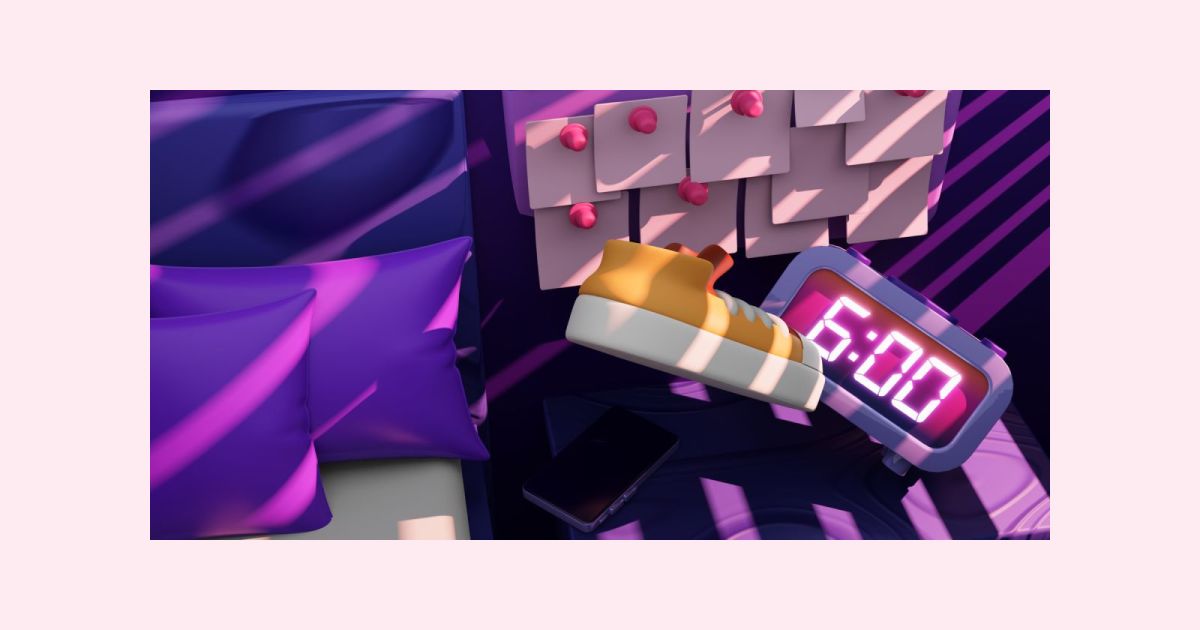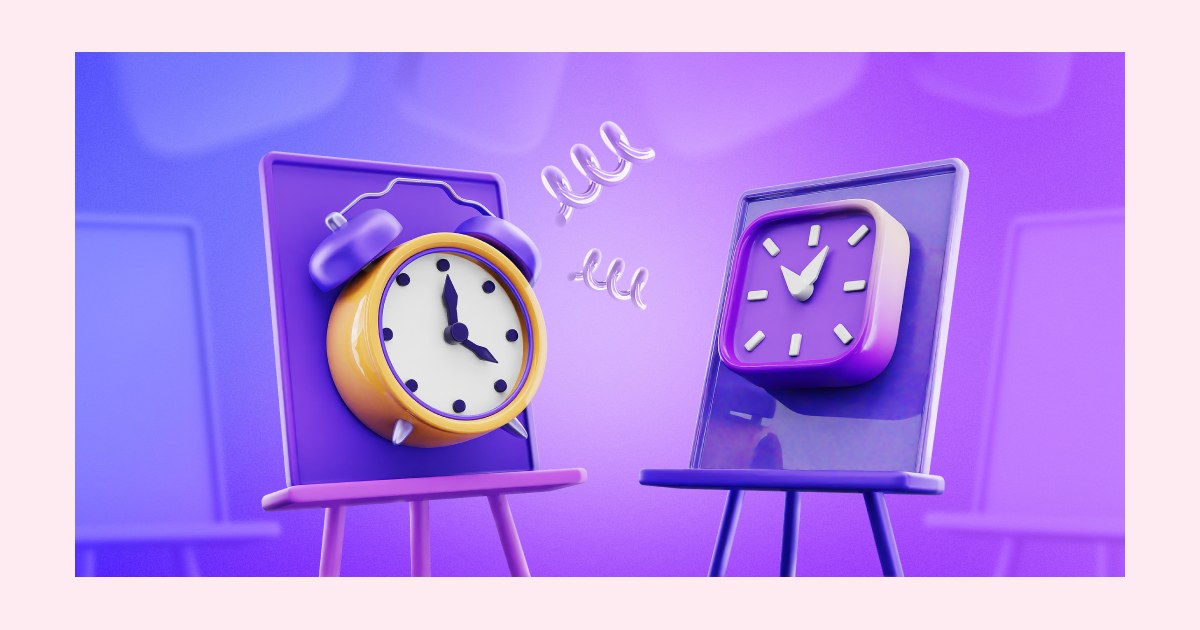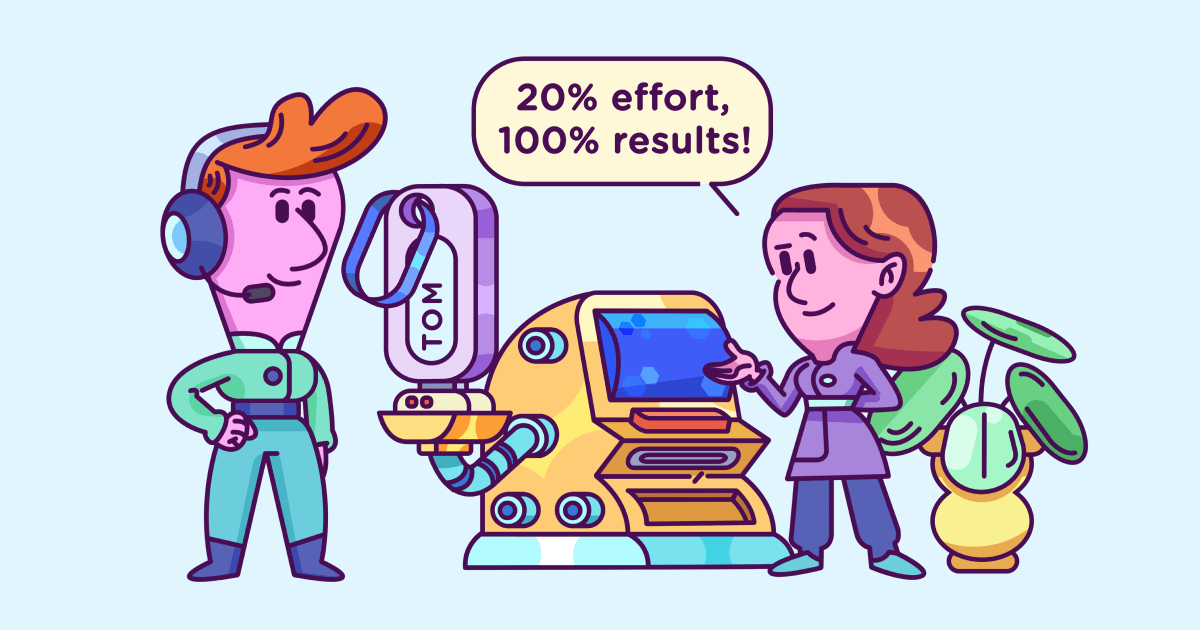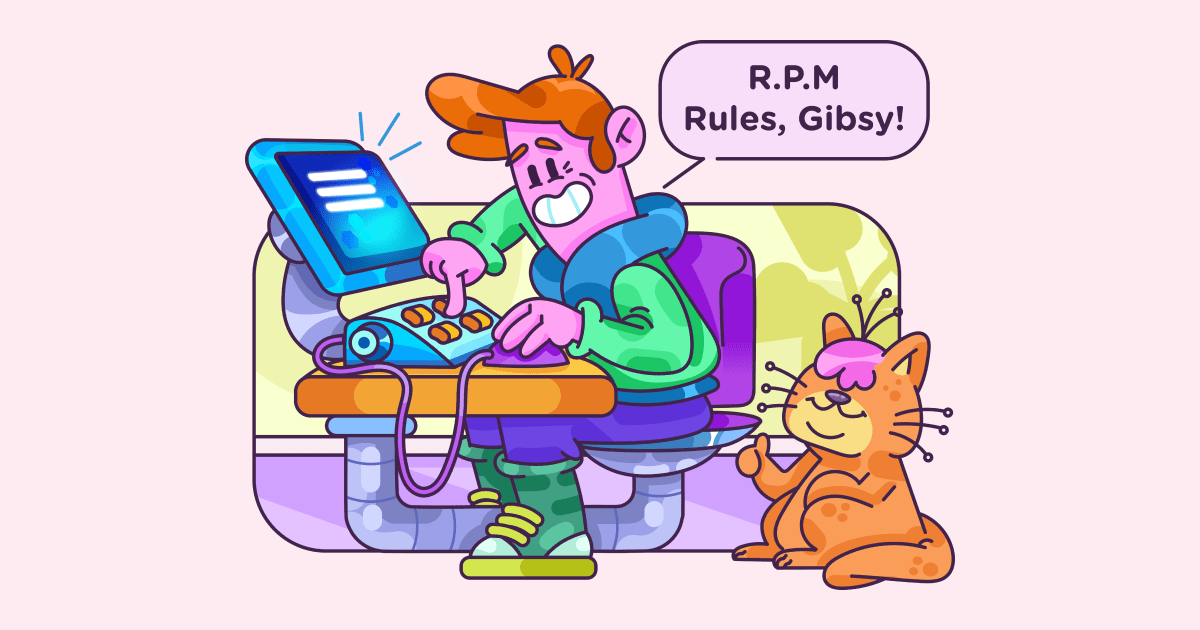The Johari window: the ultimate career self-improvement (+templates)
Last updated on: March 1, 2023
It is normal and expected to put on different appearances for different environments. How we are with our family is vastly different from how we are at the office. And even at the office, what our teammates and our team leads see can be quite different.
Now, we may think we are completely aware of how we come across to the outside world. But the truth is, there are nuances in our behavior that we’re absolutely oblivious of. The Johari window aims to point out these nuances so that we can learn how others see us, and how we can use this knowledge to advance in our careers.
In this article, we’ll be taking a look at what makes the Johari window so successful, why it’s a must for every working person, and how you can use it for self-improvement.
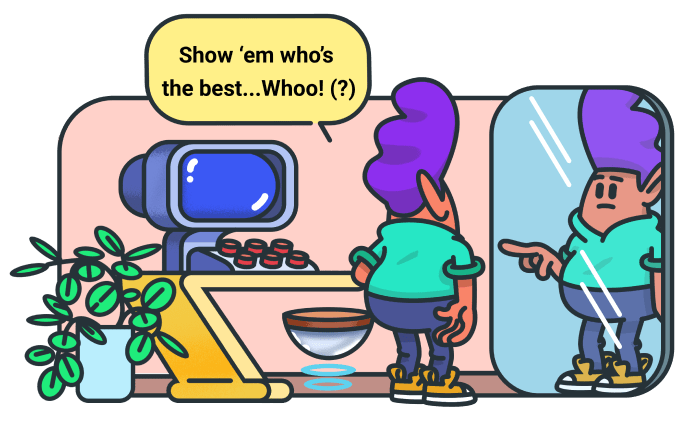
Table of Contents
How do others see you?
Storytime: At my former workplace, my team lead and I had just finished a meeting with some other team leads, where I was pitching a few ideas on an ongoing project. As we were walking back to the office, he pointed out something interesting:
“You really can’t show insecurity like that, you know? They’ll eat you up.”
I looked back at him, wide-eyed, and asked what he meant by that. Sure, I felt a little nervous in the meeting, but I was convinced I did really well for a junior in a room full of seniors.
“Every time you were unsure about something, you would cross your arms and cover your mouth.”
And then I remembered how, at one point during the meeting, he even bopped my elbow gently because I started talking through my hands. At the time, I chalked it up to him correcting my unprofessional posture, but it turns out the gesture meant something else.
“Never cover your mouth. There was nothing to be nervous about, you were good and well-argued. But others can catch that and see you as unreliable, or worse — use it to push you around.”
That stuck with me. Even six years later. And it will stay in the back of my mind for years to come. It’s fascinating how we can see ourselves one way, and believe we are projecting one image, when in reality… the little things give away a whole different picture about us.
What is the Johari window?
My feedback was unplanned, and came about due to a situation I normally wouldn’t find myself in — the Johari window basically emulates this kind of encounter. At its core, it is a model that helps us understand more about how we see ourselves and how we present ourselves to others. Through this model, your coworkers can give the kind of feedback you normally wouldn’t get.
While researching group dynamics, American psychologists Joseph Luft and Harrington Ingham created a method to help self-reflection. The research was published in 1955 (almost 60 years ago!), but it’s relevant to this day.
The exercise is simple: it includes a four-square table, and a list of 57 adjectives. You and a few other chosen coworkers work on filling in each square with all the adjectives that can be used to describe you.

What are the 4 areas of the Johari window?
Upon searching through images for this method, the first thing you notice is that it looks like a window with four panes, hence the name.
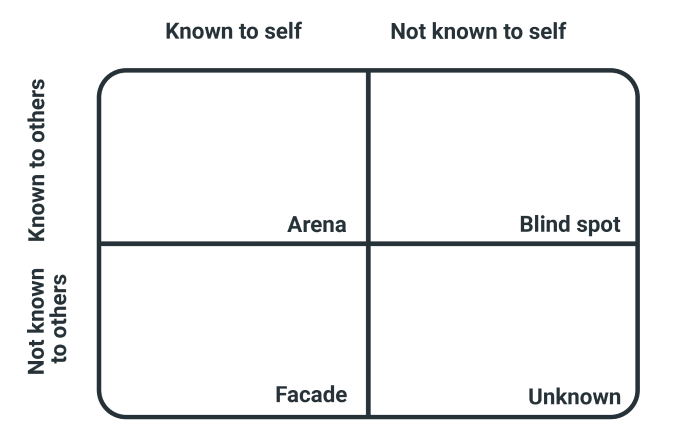
Each of these panes or areas has its purpose.
The Open Area — What is known to us and known to others
The Open Area is the area of our personality we willingly show, and that others can see. For example, the qualifications from your resume, or how you perform on your daily tasks.
In my case, my coworkers know what my style of writing is like, they know I’m talkative and open for feedback, and that I’m willing to take on an odd task every now and then, just to learn more.
The Hidden Area — What is known to us but hidden from others
The Hidden Area is the area that is known to us, but not known to others. It’s things we don’t usually willingly share with others, unless prompted, or a situation comes up. For example, our marketing team didn’t know that one of our coworkers had a great sense of humor, until one day we were playing a board game during team building.
She never had the opportunity to show that side of herself in the office, but once she did, everyone loved it. Her humorous side made everyone realize she was much more approachable than they thought.
So, in this case, our coworker knew she was funny and sociable, but others didn’t until a situation came up, and she was able to share that.
The Blind Spot — What is known to others but hidden from us
The Blind Spot is the area with information others have about ourselves, but we most likely aren’t aware of them. It’s the real outside image we are projecting. Sometimes, our perception and outside projection have things in common (we think we are extroverted, and people see us as such), but oftentimes there are small traits or patterns of behavior that reveal things we’re unaware of. Like in my story, the hand on my mouth showed insecurity, to which I was completely blind.
This is essential outside information for our personal and career development. What we don’t know, in this case, can kill us. Figuratively. Or at least, kill our career opportunities.
The Unknown — What is hidden from both us and others
The Unknown area contains all the traits and skills we don’t know we have, and neither do those around us. For example, you can’t know how you’d deal with a tight deadline, or if you’d be able to handle an unproductive team as a lead, unless you’ve been in such a situation.
Now, of course, you won’t start sabotaging your work just to see if you have hidden skills or talents, but you can expose yourself to situations outside of your comfort zone. In addition, ask more people, or friends and family to do the exercise so you can gather more information.
How does the Johari window help with my career?
The main question remains: What does the Johari window tell us?
Taking my story as an example, the team lead (who’s worked with me a year by that point) was able to notice a behavior pattern I was unaware of. He pointed out a Blind Spot which I reflected on. He pointed out I looked insecure and doubtful, when I actually didn’t feel that way.
This is how the Johari window works. It aims to show you what you think you project vs what you actually project. And what you do with that information can bring about many benefits:
- You learn of weak spots in your skillset you could improve;
- You can identify behavioral patterns that could be damaging your professional image;
- There may be positive traits you’re unintentionally displaying (but others spotted them);
- It’s great positive feedback for those less confident in their work persona;
- You can identify which skills you need to share more openly to get noticed;
- You can lessen the tension within teams, etc.
How to use the Johari window
If the benefits of the Johari window seem appealing to you, and you feel like doing the method, we’ll break up the exercise into easy-to-follow steps and offer guidance on how to interpret the results. The Johari method itself is fairly easy and even entertaining to do, as you’ll see.
You can download our free Johari window template, along with the adjective list, courtesy of our HR manager, Biljana Rakić.
1. Set up the exercise
Find any number of coworkers willing to help you out. The only conditions are that they know you for at least 6-10 months and have worked with you to some extent.
If you are a team manager wanting to conduct this exercise with employees, then you can organize the exercise with your HR manager.
2. Fill out the four areas of the Johari window
When you’ve gathered enough people, you send them the list of adjectives, and then do the following:
- From the list of given adjectives, you select six that you feel best describe yourself in the workplace;
- Ask your coworkers (or a supervisor or team lead) to choose six adjectives that they feel best represent you;
- After everyone makes their choices, you can start filling out the four areas:
- In the Open Area, you write the same adjectives you and others selected. For every person who chose the same, you put one notch (for example, I chose extrovert, and one more person did the same, so I put one notch next to it).
- The Blind Spot area is all the adjectives others chose for you, but you didn’t choose for yourself.
- The Hidden Area contains all the adjectives you chose, but no one else did.
- The Unknown holds all the adjectives that neither you nor others have chosen.
To get a better idea of what the end result looks like, here’s how my Johari window turned out:
| OPEN AREA | BLIND SPOT |
| Adaptable II, Reflective I, Extroverted I | Witty, Knowledgeable III, Clever I, Searching, Intelligent, Kind, Introverted, Complex, Energetic, Relaxed, Caring I, Trustworthy I, Warm, Sympathetic, Able, Calm, Friendly, Patient |
| HIDDEN AREA | UNKNOWN |
| Independent, Observant, Helpful | Accepting, Bold, Brave, Cheerful, Confident, Dependable, Dignified, Giving, Happy, Idealistic, Ingenious, Intelligent, Logical, Loving, Mature, Modest, Nervous, Organised, Powerful, Proud, Quiet, Religious, Responsive, Self-assertive, Self-conscious, Sensible, Sentimental, Shy, Silly, Spontaneous, Tense, Wise |
I asked five coworkers who worked with me the longest to choose six words from the original Johari list. Let’s take a look at how you’re supposed to interpret the list, and how great it actually is for career development and self-improvement. You can decide to do the original Johari window (although it’s old), or our updated version, courtesy of our own HR manager.
💡 Pro tip: You can download free Johari window templates here:
How to analyze the Johari window
To get the full benefits of this exercise, you need a discussion after the window is completed. In my case, we came to some interesting conclusions.
1. Read the Johari window
Of course, the first step is to read the window itself and then each individual area. While you can do this exercise alone, introspection can be tricky, since we’re very subjective. If possible, consult your HR manager to help you reach the most accurate conclusions.
Pay attention to the window size
The window itself can give you the first overview of your situation. Before you start placing the adjectives, all four areas of the window are of equal size. As you fill them in, you will notice how the sizes shift. At first, odds are that the Unknown area will be the largest. And the goal is for the Open Area to be the largest, and for the Unknown to be the smallest. After all, you want the image you have of yourself and the one you present in the workplace to be the same. If there are damaging habits or behaviors you’re unaware of, you would want to change them, no? In short, the window sizes point to:
- What is the most dominant area currently;
For me, it is still the Unknown, which shows me I need to put myself in more diverse work situations and ask for feedback from other coworkers.
- Which traits you think you are projecting but aren’t registered by others;
Again, for my example, I was convinced I came off as helpful. But thinking about it, no one ever outright asked for help, nor did I have an opportunity to mentor or answer someone’s requests. It could also be that others perceive me as helpful, but it’s not prominent enough to choose it.
- What direction you should go in to improve your self-image;
If your Blind Spot area is also much larger, then you can get an insight into unique qualities you may not have known are there. That way, you can decide on making those traits more prominent by consciously employing them.
Notice which adjectives repeat the most
I was surprised to see that 3 out of 5 people saw me as “adaptable” because I didn’t know if it showed. Like everyone else, I’m not made of stone, and big changes can be scary. Oftentimes, I’ll be mortified at the idea of failure when a change is introduced, and most of the time, I’m self-conscious about it showing. However, I do my best to power through, and I was glad to see my doubts were unfounded.
On the other hand, a whopping 4 out of 5 saw me as knowledgeable, which shocked me, as funny as it sounds. I don’t consider myself particularly knowledgeable, just as a “jack of all trades”, so this was a nice confidence boost.
But, how can you use these repeating adjectives in the context of self-improvement? Let’s find out in the next section.
2. Draw conclusions from the adjective lists
Now, the best kind of reflection would be done with an HR manager present, as they can guide you through the whole process. However, that doesn’t mean you can’t do some introspection on your own. With the courtesy of our own HR manager, here’s a list of questions to help you analyze the information you’ve gathered.
- My personal traits that are well-known are:
- (here, you reflect on the Open Area section)
- Other people think that I am:
- (here, you reflect on the Blind Spot section)
- I would prefer it if people saw more of:
- (here, you reflect on your Hidden Area)
Writing out the list of adjectives in a longer form can immensely help in sorting out your thoughts. It will also provide you with a starting point for improvement. These can range from building and improving on time management skills to learning how to be more trusting with others.
3. Use the findings to make an action plan
Since the goal is to expand the Open Area of the Johari window, you should focus on making the Blind Spot and the Hidden Area smaller.
Use the Blind Spots to find places for improvement
This area of the Johari window gets progressively smaller as you ask for feedback. However, it’s crucial for identifying things you don’t see, but are evident to others.
To bring back my former work anecdote, holding my hand near my mouth was an obvious Blind Spot that I’ve since rectified. You can do the same by asking your coworkers to elaborate on their choices of adjectives. For example, If you find out someone perceives you as an introvert while you consider yourself extroverted. This will make people less likely to approach you, resulting in missed opportunities. If you ask coworkers to elaborate, you could find out you have some habits that send the wrong signals:
- You always sit in the back at the office or in a meeting;
- You have headphones in at all times;
- You never get past a mere “hello” in the kitchen when other people enter the room.
Fixing that habit would include being more mindful of where you sit in the office, or in meetings, starting a conversation every now and then, or taking a break from headphones at set hours in the day.
Use the Hidden Area to learn what you can share
The Hidden Area is all about what we think we are projecting to the outside world. It’s both the things we want to share, and also those we keep to ourselves (like ideals, political beliefs, etc.)
To make our Hidden Area smaller, we need to be ready to willingly share information with others. This can be done in several ways: offering help, asking for different types of tasks, or even asking to hold a presentation or class on a skill you think will be useful to others.
In my Johari window, I’ve noticed that Independence was an adjective no one used. After some planning, I’ll probably look for tasks that are slightly out of my safe zone, and do my best to rely more on myself and my own skills, and less on guidance. That way, I can project the independence I originally wanted.
Use the Unknown area for self-reflection and future planning
Anything that remained in the Unknown area is… well, unknown. No one noticed those traits about you, nor can you with certainty say you possess them. In order to make this area less of a mystery, you can expose yourself to new challenges — like signing up for courses, trying out new tasks you’d normally turn down, and so on. Alternatively, you can spend some time thinking back to old work situations (or even those in your personal life) and recall how you’ve acted —situations like conflicts, reprimands, pressure (both work and personal), specific achievements, and so on.
Jennifer Porter, Managing Partner of The Boda Group, wrote a great article on self-reflection and the right questions to ask to draw useful conclusions.
What are the benefits of the Johari window?
This exercise makes it easier and more accessible to reflect on ourselves and our coworkers. Since its premise is simple (choose six adjectives), people are more likely to share feedback. We all get apprehensive when we’re given an empty page and asked to fill it in with appropriately written opinions, or answer dozens of questions. But with Johari window:
- It’s easier for people to find the words to describe you;
- There are no negative adjectives, making the feedback more constructive;
- For managers and HR, it works like a simpler version of 360-degree feedback.
Not to mention that the Johari window can be spotted even in casual conversation. When I asked my HR about the method, she gave me the funniest example:
Jamie: You just got a puppy? I have two dogs myself. //Hidden area
Hank: Really? I had no idea! Although I did notice you sometimes have hairs on your cardigans. I thought they were yours. //Blind Spot
Jamie: I genuinely didn’t notice that.
Hank: No, it makes more sense now.
In this exchange, we can see both Jamie disclosing something about herself (that she’s a responsible dog owner), and finding a Blind Spot (she doesn’t check her clothes for dog hair before leaving the house).
This particular Blind Spot can also help Jamie reflect on a deeper level. It may make her realize:
- That she rushes through her morning routine before leaving the house;
- That she doesn’t pay that much attention to her physical appearance;
- That she’s not getting enough sleep lately (therefore missing details);
Of course, depending on the situation and the person, conclusions will be much different. So it’s probably best to have an HR manager conduct this kind of exercise, as they can guide people through it and ensure you get the most accurate readings.
Conclusion
When implemented correctly, the Johari window can be the most valuable tool in every employee’s and manager’s toolbox. It provides information about our workflow and personality that would normally go under the radar. These insights are useful, as we can use them to build on our existing professional persona — we can fix our flaws, enhance our good qualities, and maximize on skills that seem to be most prominent. It can help you find better work, focus on learning new things and help you understand better how others see you.
✉️ Have you tried out the Johari window for yourself? How did the template work out for you? Let us know what you think on blogfeedback@clockify.me, and we might feature your feedback in one of our future articles.
